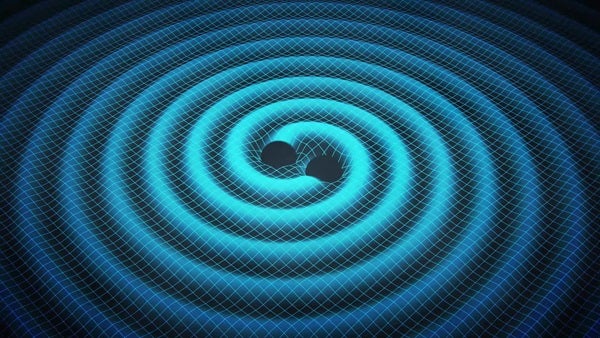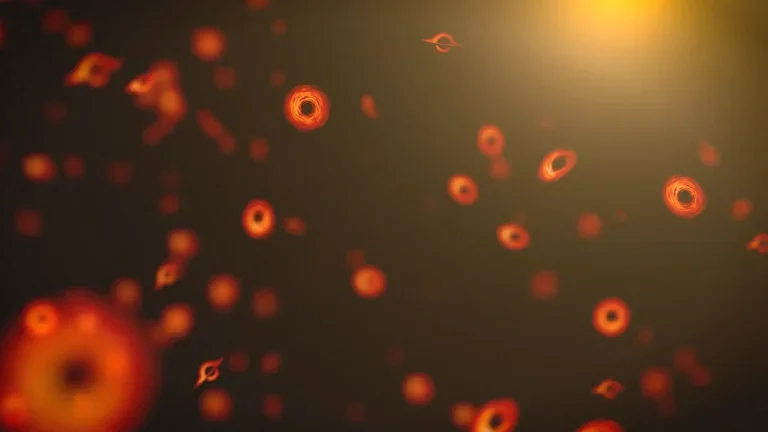On September 14, 2015, the Laser Interferometer Gravitational-wave Observatory (LIGO) detected gravitational waves from the merger of two black holes 29 and 36 times the mass of the Sun. Such an event is expected to be dark, but the Fermi Space Telescope detected a gamma-ray burst just a fraction of a second after LIGO’s signal. New research suggests that the two black holes might have resided inside a single, massive star whose death generated the gamma-ray burst.
“It’s the cosmic equivalent of a pregnant woman carrying twins inside her belly,” says Harvard astrophysicist Avi Loeb of the Harvard-Smithsonian Center for Astrophysics (CfA).
Normally, when a massive star reaches the end of its life, its core collapses into a single black hole. But if the star was spinning very rapidly, its core might stretch into a dumbbell shape and fragment into two clumps, each forming its own black hole.
A very massive star as needed here often forms out of the merger of two smaller stars. And since the stars would have revolved around each other faster and faster as they spiraled together, the resulting merged star would be expected to spin very quickly.
After the black hole pair formed, the star’s outer envelope rushed inward toward them. In order to power both the gravitational wave event and the gamma-ray burst, the twin black holes must have been born close together, with an initial separation of order the size of the Earth, and merged within minutes. The newly formed single black hole then fed on the infalling matter, consuming up to a Sun’s worth of material every second and powering jets of matter that blasted outward to create the burst.
Fermi detected the burst just 0.4 seconds after LIGO detected gravitational waves, and from the same general area of the sky. However, the European INTEGRAL gamma-ray satellite did not confirm the signal.
“Even if the Fermi detection is a false alarm, future LIGO events should be monitored for accompanying light irrespective of whether they originate from black hole mergers. Nature can always surprise us,” says Loeb.
If more gamma-ray bursts are detected from gravitational wave events, they will offer a promising new method of measuring cosmic distances and the expansion of the universe. By spotting the afterglow of a gamma-ray burst and measuring its redshift, then comparing it to the independent distance measurement from LIGO, astronomers can precisely constrain the cosmological parameters. “Astrophysical black holes are much simpler than other distance indicators, such as supernovae, since they are fully defined just by their mass and spin,” says Loeb.
“This is an agenda-setting paper that will likely stimulate vigorous follow-up work, in the crucial period after the initial LIGO discovery, where the challenge is to fathom its full implications. If history is any guide, the ‘multi-messenger’ approach advocated by Loeb, using both gravitational waves and electromagnetic radiation, again promises deeper insight into the physical nature of the remarkable LIGO source,” says Volker Bromm of the University of Texas at Austin, commenting independently.
This research has been accepted for publication in The Astrophysical Journal Letters and is available online.
On September 14, 2015, the Laser Interferometer Gravitational-wave Observatory (LIGO) detected gravitational waves from the merger of two black holes 29 and 36 times the mass of the Sun. Such an event is expected to be dark, but the Fermi Space Telescope detected a gamma-ray burst just a fraction of a second after LIGO’s signal. New research suggests that the two black holes might have resided inside a single, massive star whose death generated the gamma-ray burst.
“It’s the cosmic equivalent of a pregnant woman carrying twins inside her belly,” says Harvard astrophysicist Avi Loeb of the Harvard-Smithsonian Center for Astrophysics (CfA).
Normally, when a massive star reaches the end of its life, its core collapses into a single black hole. But if the star was spinning very rapidly, its core might stretch into a dumbbell shape and fragment into two clumps, each forming its own black hole.
A very massive star as needed here often forms out of the merger of two smaller stars. And since the stars would have revolved around each other faster and faster as they spiraled together, the resulting merged star would be expected to spin very quickly.
After the black hole pair formed, the star’s outer envelope rushed inward toward them. In order to power both the gravitational wave event and the gamma-ray burst, the twin black holes must have been born close together, with an initial separation of order the size of the Earth, and merged within minutes. The newly formed single black hole then fed on the infalling matter, consuming up to a Sun’s worth of material every second and powering jets of matter that blasted outward to create the burst.
Fermi detected the burst just 0.4 seconds after LIGO detected gravitational waves, and from the same general area of the sky. However, the European INTEGRAL gamma-ray satellite did not confirm the signal.
“Even if the Fermi detection is a false alarm, future LIGO events should be monitored for accompanying light irrespective of whether they originate from black hole mergers. Nature can always surprise us,” says Loeb.
If more gamma-ray bursts are detected from gravitational wave events, they will offer a promising new method of measuring cosmic distances and the expansion of the universe. By spotting the afterglow of a gamma-ray burst and measuring its redshift, then comparing it to the independent distance measurement from LIGO, astronomers can precisely constrain the cosmological parameters. “Astrophysical black holes are much simpler than other distance indicators, such as supernovae, since they are fully defined just by their mass and spin,” says Loeb.
“This is an agenda-setting paper that will likely stimulate vigorous follow-up work, in the crucial period after the initial LIGO discovery, where the challenge is to fathom its full implications. If history is any guide, the ‘multi-messenger’ approach advocated by Loeb, using both gravitational waves and electromagnetic radiation, again promises deeper insight into the physical nature of the remarkable LIGO source,” says Volker Bromm of the University of Texas at Austin, commenting independently.
This research has been accepted for publication in The Astrophysical Journal Letters and is available online.
Headquartered in Cambridge, Mass., the Harvard-Smithsonian Center for Astrophysics (CfA) is a joint collaboration between the Smithsonian Astrophysical Observatory and the Harvard College Observatory. CfA scientists, organized into six research divisions, study the origin, evolution and ultimate fate of the universe.
– See more at: https://www.cfa.harvard.edu/news/2016-05#sthash.onXCzI9X.dpuf
On September 14, 2015, the Laser Interferometer Gravitational-wave Observatory (LIGO) detected gravitational waves from the merger of two black holes 29 and 36 times the mass of the Sun. Such an event is expected to be dark, but the Fermi Space Telescope detected a gamma-ray burst just a fraction of a second after LIGO’s signal. New research suggests that the two black holes might have resided inside a single, massive star whose death generated the gamma-ray burst.
“It’s the cosmic equivalent of a pregnant woman carrying twins inside her belly,” says Harvard astrophysicist Avi Loeb of the Harvard-Smithsonian Center for Astrophysics (CfA).
Normally, when a massive star reaches the end of its life, its core collapses into a single black hole. But if the star was spinning very rapidly, its core might stretch into a dumbbell shape and fragment into two clumps, each forming its own black hole.
A very massive star as needed here often forms out of the merger of two smaller stars. And since the stars would have revolved around each other faster and faster as they spiraled together, the resulting merged star would be expected to spin very quickly.
After the black hole pair formed, the star’s outer envelope rushed inward toward them. In order to power both the gravitational wave event and the gamma-ray burst, the twin black holes must have been born close together, with an initial separation of order the size of the Earth, and merged within minutes. The newly formed single black hole then fed on the infalling matter, consuming up to a Sun’s worth of material every second and powering jets of matter that blasted outward to create the burst.
Fermi detected the burst just 0.4 seconds after LIGO detected gravitational waves, and from the same general area of the sky. However, the European INTEGRAL gamma-ray satellite did not confirm the signal.
“Even if the Fermi detection is a false alarm, future LIGO events should be monitored for accompanying light irrespective of whether they originate from black hole mergers. Nature can always surprise us,” says Loeb.
If more gamma-ray bursts are detected from gravitational wave events, they will offer a promising new method of measuring cosmic distances and the expansion of the universe. By spotting the afterglow of a gamma-ray burst and measuring its redshift, then comparing it to the independent distance measurement from LIGO, astronomers can precisely constrain the cosmological parameters. “Astrophysical black holes are much simpler than other distance indicators, such as supernovae, since they are fully defined just by their mass and spin,” says Loeb.
“This is an agenda-setting paper that will likely stimulate vigorous follow-up work, in the crucial period after the initial LIGO discovery, where the challenge is to fathom its full implications. If history is any guide, the ‘multi-messenger’ approach advocated by Loeb, using both gravitational waves and electromagnetic radiation, again promises deeper insight into the physical nature of the remarkable LIGO source,” says Volker Bromm of the University of Texas at Austin, commenting independently.
This research has been accepted for publication in The Astrophysical Journal Letters and is available online.
Headquartered in Cambridge, Mass., the Harvard-Smithsonian Center for Astrophysics (CfA) is a joint collaboration between the Smithsonian Astrophysical Observatory and the Harvard College Observatory. CfA scientists, organized into six research divisions, study the origin, evolution and ultimate fate of the universe.
– See more at: https://www.cfa.harvard.edu/news/2016-05#sthash.onXCzI9X.dpuf










